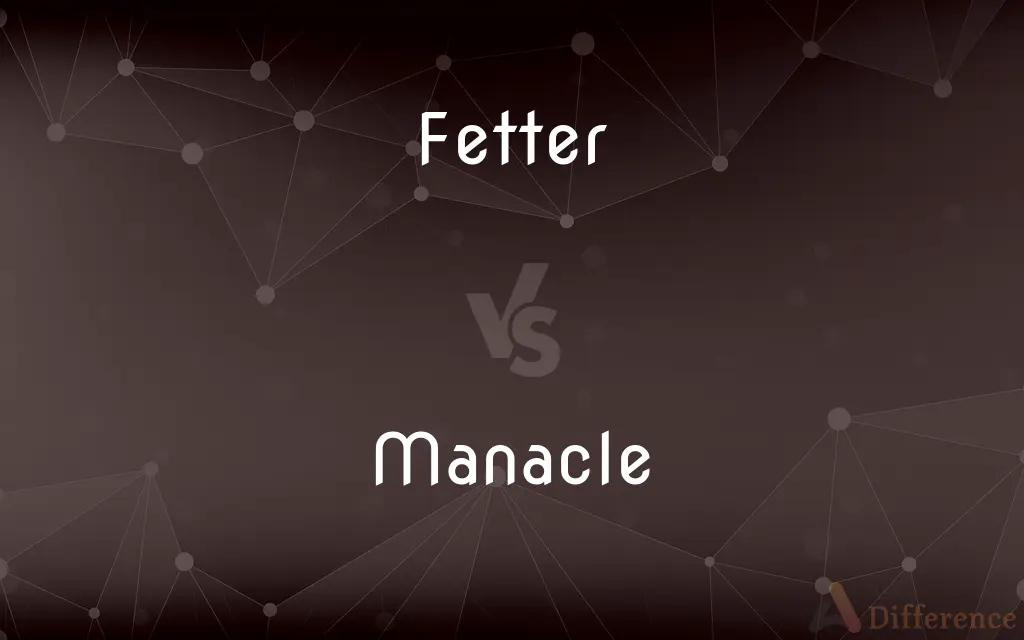Fetter vs. Manacle — What's the Difference?
Edited by Tayyaba Rehman — By Fiza Rafique — Updated on April 8, 2024
Fetter refers to a chain or shackle for the feet, symbolizing restraint, while a manacle is a shackle for the hands, indicating captivity.

Difference Between Fetter and Manacle
Table of Contents
ADVERTISEMENT
Key Differences
Fetters are typically used to restrict the movement of the feet, historically made from chains or shackles. They have been employed for various purposes, including punishment, enslavement, or the restraint of prisoners. The term "fetter" can also metaphorically refer to any form of restriction or limitation placed upon an individual's freedom or ability to act. On the other hand, manacles are specifically designed to bind the hands, preventing the wearer from using their hands freely. Manacles have been used in similar contexts as fetters but are distinct in their application to the hands, symbolizing a more direct limitation on an individual's actions and abilities.
The symbolism associated with fetters and manacles extends beyond their physical use. Fetters, by restricting the feet, can symbolize the suppression of one's ability to progress or move forward in life, whether due to external constraints or personal circumstances. Manacles, by binding the hands, often represent a loss of power or control, limiting an individual's ability to interact with their environment or to defend themselves. Both terms have thus found their way into literature and discourse as metaphors for various forms of oppression or constraint.
The historical context in which fetters and manacles have been used reveals much about their significance in various cultures. Fetters were often used in ancient and medieval times not only as means of punishment but also as methods of humiliating captives or slaves, visibly marking their lower status. Manacles, with their focus on immobilizing the hands, have been particularly associated with the restraint of prisoners and slaves, emphasizing the removal of agency and control.
In contemporary usage, the distinction between fetters and manacles remains largely the same, though the prevalence of their physical use has diminished in many societies due to changes in laws and attitudes towards punishment and restraint. However, their metaphorical significance persists, frequently invoked to describe legal, social, or personal constraints that limit freedom or agency. The imagery of fetters and manacles continues to evoke a strong response, symbolizing the struggle against oppression and the desire for liberty.
Despite their differences, both fetters and manacles share a common purpose: to control or limit the movement and capabilities of an individual. The choice between the two often depends on the specific intention behind the restraint—whether to limit mobility (fetters) or to restrict the use of one's hands (manacles). In both historical and contemporary contexts, these restraints serve as powerful symbols of control, oppression, and the denial of freedom.
ADVERTISEMENT
Comparison Chart
Definition
A chain or shackle for the feet
A shackle for the hands
Symbolism
Restriction of movement, progression
Loss of control, power
Use
Punishment, enslavement, restraint
Restraint, particularly of prisoners or slaves
Metaphorical Use
Limitations on freedom or ability to act
Suppression of agency or ability to interact
Historical Context
Used in ancient and medieval times for humiliation and control
Associated with imprisonment and removal of agency
Compare with Definitions
Fetter
A chain or shackle for the feet.
The prisoner was placed in fetters to prevent his escape.
Manacle
Associated with the inability to act or defend.
The hero found himself manacled, unable to fight back.
Fetter
Can refer to physical or metaphorical restraints.
Society's norms can act as fetters on creativity.
Manacle
Indicates captivity or the loss of freedom.
The metaphor of manacles is often used to describe addiction.
Fetter
Historically used for punishment or control.
The captives were brought in, bound in fetters.
Manacle
Common in contexts of imprisonment or slavery.
Historical accounts describe slaves transported in manacles.
Fetter
Often used in literature to represent oppression.
The poet wrote of fetters binding the spirit.
Manacle
Symbolizes direct control over an individual's actions.
The narrative described love as manacles that bound her will.
Fetter
Symbolizes restraint or limitation.
He saw his obligations as a fetter to his ambitions.
Manacle
A shackle for the hands.
The guards secured the thief with manacles.
Fetter
A chain or manacle used to restrain a prisoner, typically placed around the ankles
He lay bound with fetters of iron
Manacle
A device for confining the hands, usually consisting of a set of two metal rings that are fastened about the wrists and joined by a metal chain.
Fetter
Restrain with chains or manacles, typically around the ankles
The Supervisor tossed a key to the old slave to unlock the chain that fettered the prisoners together
Manacle
Something that confines or restrains
"caught in the manacles of their language" (Cynthia Ozick).
Fetter
A device, usually one of a pair of rings connected to a chain, that is attached to the ankles or feet to restrict movement.
Manacle
To put manacles on (someone); restrain with manacles.
Fetter
Often fetters Something that serves to restrict; a restraint
The fetters of tyranny.
Manacle
To restrain the action or progress of
"[She was] manacled by the restrictions of an overbearing father" (Lilian Faderman).
Fetter
To put fetters on; shackle.
Manacle
A shackle for the wrist, usually consisting of a pair of joined rings; a handcuff; (by extension) a similar device put around an ankle to restrict free movement.
Fetter
To restrict or restrain
Thinking that is fettered by prejudice.
Manacle
(figuratively) A fetter, a restriction.
Fetter
A chain or similar object used to bind a person or animal – often by its legs (usually in plural).
Manacle
(ambitransitive) To confine with manacles.
Fetter
(figurative) Anything that restricts or restrains.
Manacle
A handcuff; a shackle for the hand or wrist; - usually in the plural.
Doctrine unto fools is as fetters on the feet, and like manacles on the right hand.
Fetter
(transitive) To shackle or bind up with fetters.
Manacle
To put handcuffs or other fastening upon, for confining the hands; to shackle; to confine; to restrain from the use of the limbs or natural powers.
Is it thus you use this monarch, to manacle and shackle him hand and foot ?
Fetter
(transitive) To restrain or impede; to hamper.
Manacle
Shackle that consists of a metal loop that can be locked around the wrist; usually used in pairs
Fetter
A chain or shackle for the feet; a chain by which an animal is confined by the foot, either made fast or disabled from free and rapid motion; a bond; a shackle.
[They] bound him with fetters of brass.
Manacle
Confine or restrain with or as if with manacles or handcuffs;
The police handcuffed the suspect at the scene of the crime
Fetter
Anything that confines or restrains; a restraint.
Passion's too fierce to be in fetters bound.
Fetter
To put fetters upon; to shackle or confine the feet of with a chain; to bind.
My heels are fettered, but my fist is free.
Fetter
To restrain from motion; to impose restraints on; to confine; to enchain; as, fettered by obligations.
My conscience! thou art fetteredMore than my shanks and wrists.
Fetter
A shackle for the ankles or feet
Fetter
Restrain with fetters
Common Curiosities
Can the terms fetter and manacle be used interchangeably?
While they serve similar purposes of restraint, they are not interchangeable due to their specific applications to feet and hands, respectively.
What do fetters symbolize in literature?
Fetters often symbolize oppression, restraint, or the hindrance of progress and freedom.
Were fetters and manacles used for different purposes historically?
Yes, both were used for punishment and control, but fetters primarily limited movement, while manacles restricted the use of hands, reflecting different forms of captivity.
What does it mean to be "in fetters"?
To be "in fetters" can mean to be physically restrained by shackles on the feet or to be metaphorically restricted by some form of limitation or constraint.
What is the primary difference between a fetter and a manacle?
A fetter is a shackle for the feet, while a manacle is a shackle for the hands.
How are manacles used in contemporary society?
Manacles, or handcuffs in modern terms, are primarily used by law enforcement for the temporary restraint of individuals.
How do manacles represent a loss of control?
By restricting the hands, manacles symbolize a direct limitation on one's ability to interact, work, or defend oneself, representing a loss of agency.
Do fetters and manacles have cultural significance?
Yes, in various cultures, they symbolize the struggle against oppression and the fight for freedom.
How do fetters and manacles differ in their impact on individuals?
While both restrict freedom, fetters mainly limit mobility, symbolizing hindrance, whereas manacles limit the use of hands, representing a loss of control and agency.
Can fetters and manacles have metaphorical meanings?
Absolutely, both are frequently used metaphorically to describe various forms of social, legal, or personal constraints.
Share Your Discovery

Previous Comparison
Nordic vs. Aryan
Next Comparison
Greeting vs. RegardsAuthor Spotlight
Written by
Fiza RafiqueFiza Rafique is a skilled content writer at AskDifference.com, where she meticulously refines and enhances written pieces. Drawing from her vast editorial expertise, Fiza ensures clarity, accuracy, and precision in every article. Passionate about language, she continually seeks to elevate the quality of content for readers worldwide.
Edited by
Tayyaba RehmanTayyaba Rehman is a distinguished writer, currently serving as a primary contributor to askdifference.com. As a researcher in semantics and etymology, Tayyaba's passion for the complexity of languages and their distinctions has found a perfect home on the platform. Tayyaba delves into the intricacies of language, distinguishing between commonly confused words and phrases, thereby providing clarity for readers worldwide.














































